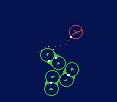Difference between revisions of "Single Bot"
From WikiManual
m |
|||
| (3 intermediate revisions by 2 users not shown) | |||
| Line 1: | Line 1: | ||
A singlebot, sometimes abbreviated as SB, is any bot made of a single cell unconnected to other cells by permanent ties. | A singlebot, sometimes abbreviated as SB, is any bot made of a single cell unconnected to other cells by permanent ties. | ||
| − | [[Image:SB1.jpg|frame|right|This is a typical Singlebot. Note the lack of permanent connective ties. It eats, lives, reproduces and dies entirely independantly (or mostly independantly) of other cells.]] | + | [[Image:SB1.jpg|frame|right|This purple circle is a typical Singlebot. Note the lack of permanent connective ties. It eats, lives, reproduces and dies entirely independantly (or mostly independantly) of other cells.]] |
---- | ---- | ||
===Singlebot Advantages=== | ===Singlebot Advantages=== | ||
| − | Singlebots are much simpler to program than multibots. They are also significantly more maneuverable. An SB that uses ties does so primarily to feed from other bots. While feeding SBs can become [ | + | Singlebots are much simpler to program than multibots. They are also significantly more maneuverable. An SB that uses ties does so primarily to feed from other bots. While feeding SBs can become [[Multibots]] but revert to SB status once feeding is complete. |
| − | + | [[Category:Bottype]] | |
| − | |||
| − | |||
Latest revision as of 18:06, 31 January 2006
A singlebot, sometimes abbreviated as SB, is any bot made of a single cell unconnected to other cells by permanent ties.
Singlebot Advantages
Singlebots are much simpler to program than multibots. They are also significantly more maneuverable. An SB that uses ties does so primarily to feed from other bots. While feeding SBs can become Multibots but revert to SB status once feeding is complete.
